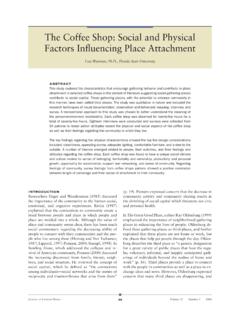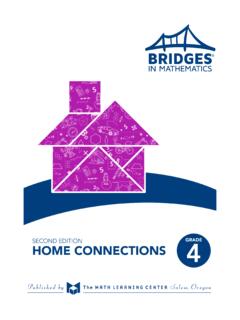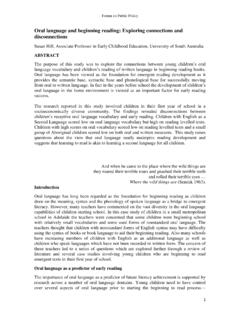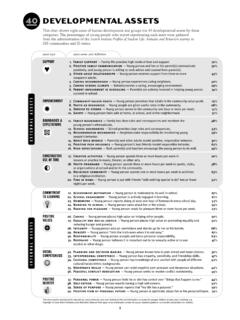Transcription of The Coffee Shop: Social and Physical factors Influencing ...
1 Journal of InterIor DesIgnVolume 31 Number 3 200635introDuctionResearchers Unger and Wandersman (1985) discussed the importance of the community to the human Social , emotional, and cognitive experiences. Rivlin (1987) explained that the connections to community create a bond between people and place in which people and place are molded into a whole. Although the value of place and community seems clear, there has been much Social commentary regarding the decreasing ability of people to connect with their communities and the peo-ple who live among them (fleming and Von Tscharner, 1987; Lippard, 1997; Putnam, 2000: Stumpf, 1998). In Bowling Alone, which addressed the collapse and re-vival of American community, Putnam (2000) discussed the increasing disconnect from family, friends, neigh-bors, and Social structure.
2 He reviewed the concept of Social capital, which he defined as the connections among individuals Social networks and the norms of reciprocity and trustworthiness that arise from them (p. 19). Putnam expressed concern that the decrease in community activity and community sharing results in the shrinking of Social capital which threatens our civic and personal health. In The Great Good Place, author Ray Oldenburg (1999) emphasized the importance of neighborhood gathering places in enhancing the lives of people. Oldenburg de-fined these gathering places as third places, and further explained that these places are not home or work, but the places that help get people through the day. Olden-burg describes the third place as a generic designation for a great variety of public places that host the regu-lar, voluntary, informal, and happily anticipated gath-erings of individuals beyond the realms of home and work (p.)
3 16). Third places provide a place to connect with the people in communities as well as a place to ex-change ideas and news. However, Oldenburg expressed concern that many third places are disappearing, and The Coffee Shop: Social and Physical factors Influencing Place AttachmentaBstractThis study explored the characteristics that encourage gathering behavior and contribute to place attachment in selected Coffee shops in the context of literature suggesting Social gathering places contribute to Social capital. These gathering places, with the potential to enhance community in this manner, have been called third places. The study was qualitative in nature and included the research techniques of visual documentation, observation and behavioral mapping, interview, and survey. A transactional approach to this study was chosen to better understand the meaning of the person-environment relationship.
4 Each Coffee shop was observed for twenty-five hours for a total of seventy-five hours. Eighteen interviews were conducted and surveys were collected from 94 patrons to reveal patron attitudes toward the Physical and Social aspects of the Coffee shop as well as their feelings regarding the community in which they live. The key findings regarding the Physical characteristics showed the top five design considerations included: cleanliness, appealing aroma, adequate lighting, comfortable furniture, and a view to the outside. A number of themes emerged related to people, their activities, and their feelings and attitudes regarding the Coffee shop. Each Coffee shop was found to have a unique Social climate and culture related to sense of belonging, territoriality and ownership, productivity and personal growth, opportunity for socialization, support and networking, and sense of community.
5 Regarding feelings of community, survey findings from Coffee shops patrons showed a positive correlation between length of patronage and their sense of attachment to their community. Lisa Waxman, , Florida State UniversityJournal of InterIor DesIgnVolume 31 Number 3 200636that in the United States, the third place has become a distant third. He raised the question of how this de-crease in the availability of community gathering places impacts the lives of people. What are the consequences when communities lack places to gather with neigh-bors, friends, and to mingle with the familiar strangers who hold the potential for new friendships, relation-ships, and ultimately the growth of the Social capital in a community? Oldenburg (1999) explained that most third places draw their identity from the beverages they serve.
6 His-torically, Coffee houses have provided places for Social intercourse and conversation, as well as political debate (Pendergrast, 1999). They have also served as places where people could gather, speak freely, and mingle with others from their communities (Oldenburg, 1999). for many people, the Coffee shop serves as a third place, a place to regularly interact with fellow community mem-bers. In the United States, from 2000 to 2004, fast food chains grew at a rate of 2% per year, while Coffee shop chains grew more than 10% annually (Holmes, 2004). In 2004, forty-two percent of adults in the United States aged 18-34 purchased their Coffee at a Coffee shop with 48% consuming the beverage on the premises. These numbers seem to indicate that the Coffee shop is about more than just Coffee ; perhaps the place in which it is consumed has significance in studying place attachment report that attach-ment to place comes about through a set of related phe-nomenon rather than a singular phenomenon (Low & Altman, 1992).
7 In addition, a number of scholars have viewed the concept of place attachment in a transaction-al framework involving psychological, Social , and tem-poral experiences (Stokols & Shumaker, 1981; Brown and Perkins, 1992; Altman & Rogoff, 1987). A defini-tion by Brown and Perkins (1992) states, Place attach-ment involves positively experienced bonds, sometimes occurring without awareness, that are developed over time from the behavioral, affective, and cognitive ties between individuals and/or groups and their sociophys-ical environment (p. 284). This research on place and place attachment points to the value of place in the lives of people. This paper will expand on this research by exploring the variables that contribute to gathering behavior and place attachment in third places, specifically Coffee shops.
8 The sites cho-sen for study included three selected Coffee shops in a mid-size city in the southeastern United States. The pur-pose of this study was to see what qualities, both physi-cal and Social , encourage people to gather in those cof-fee shops and develop an attachment to those reviewDue to the availability of literature on the Social /psy-chological studies of place, and a lack of literature on the design of Social gathering places, this review of liter-ature will focus primarily on studies of place and place attachment. The experience of place is unique to each individual and is directly related to his or her lived experiences. Attach-ment to place is a set of feelings that emotionally binds people to a particular place. Places root us to the earth, to our own history and memories, to our families and larger community (Cooper-Marcus & frances, 1998, p.)
9 Xi). Understanding the concept of place pro-vides an important framework for understanding the way people form relationships with places. When relationships develop between people and places, the result is often a feeling of place attachment. Low (1992) stated, Place attachment is the symbolic re-lationship formed by people giving culturally shared emotional/affective meanings to a particular space or piece of land that provides the basis for the individual s and group s understanding of and relation to the envi-ronment (p. 165). Proshansky, fabian, and Kaminoff (1983) described place attachment as involving the in-terplay of emotions, knowledge, beliefs, and behaviors in reference to a place. Place attachment refers to the idea that people develop special bonds with certain settings that hold deep mean-ing to the individual (Low & Altman, 1992).
10 The word the Coffee shOp: Social and Physical factors Influencing pLace attachmentWaxmanThe experience of place is unique to each individual and is directly related to his or her lived experiences. Attachment to place is a set of feelings that emotionally binds people to a particular place. Journal of InterIor DesIgnVolume 31 Number 3 200637 attachment refers to affect while the word place re-fers to the environmental settings to which people are emotionally and culturally attached (Low & Altman, 1992, p. 5). Affect, emotion, and feeling are central to the concept of place attachment and appear consistently in studies on this topic. Relph (1976) believed that to be inside a place is to belong and identify with it. Tuan (1980) suggested the existence of a state of rootedness in which one s personality merges with one s place.








